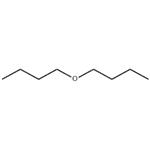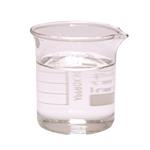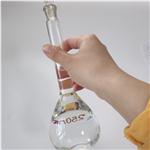- Di-n-butyl ether
-

- $100.00 / 1KG
-
2023-12-24
- CAS:142-96-1
- Min. Order: 1KG
- Purity: 99%
- Supply Ability: g-kg-tons, free sample is available
- Di-n-butyl ether
-

- $0.00 / 1kg
-
2023-11-21
- CAS:142-96-1
- Min. Order: 1kg
- Purity: 0.99
- Supply Ability: 20 tons
- Di-n-butyl ether
-

- $30.00 / 1KG
-
2023-09-06
- CAS:142-96-1
- Min. Order: 50KG
- Purity: 99%
- Supply Ability: 500000kg
Related articles - Mechanism of Butyl ether
- Butyl ether is used mainly as a solvent for organic materials such as resins, oils, hydrocarbons, esters, gums, and alkaloids.....
- Dec 2,2021
|
| | Di-n-butyl ether Basic information |
| | Di-n-butyl ether Chemical Properties |
| Melting point | -98 °C (lit.) | | Boiling point | 142-143 °C (lit.) | | density | 0.764 g/mL at 25 °C (lit.) | | vapor density | 4.48 (vs air) | | vapor pressure | 4.8 mm Hg ( 20 °C) | | refractive index | n20/D 1.399(lit.) | | Fp | 77 °F | | storage temp. | Store at <= 20°C. | | solubility | H2O: soluble0.113g/L at 20°C | | form | Liquid | | color | Clear colorless | | PH | 5.2 (0.2g/l, H2O, 20℃) | | Relative polarity | 1.7 | | Odor | Mild, ether-like. | | PH Range | 5.2 | | explosive limit | 0.9-8.5%(V) | | Water Solubility | 0.03 g/100 mL (20 ºC) | | Merck | 14,1569 | | BRN | 1732752 | | Dielectric constant | 3.1(25℃) | | Stability: | Stable. Flammable. May form peroxides in storage. Incompatible with strong oxidizing agents. | | InChIKey | DURPTKYDGMDSBL-UHFFFAOYSA-N | | LogP | 3.35 | | CAS DataBase Reference | 142-96-1(CAS DataBase Reference) | | NIST Chemistry Reference | n-Butyl ether(142-96-1) | | EPA Substance Registry System | Butyl ether (142-96-1) |
| Hazard Codes | Xi | | Risk Statements | 10-36/37/38-52/53 | | Safety Statements | 61-24/25 | | RIDADR | UN 1149 3/PG 3 | | WGK Germany | 2 | | RTECS | EK5425000 | | Autoignition Temperature | 365 °F | | Hazard Note | Irritant | | TSCA | Yes | | HazardClass | 3 | | PackingGroup | III | | HS Code | 29091990 | | Hazardous Substances Data | 142-96-1(Hazardous Substances Data) | | Toxicity | LD50 orally in rats: 7.4 g/kg (Smyth) |
| | Di-n-butyl ether Usage And Synthesis |
| Description | Butyl ether (dibutyl ether) is a colorless, stable liquid, with a mild ether-like odor. It is immiscible with water, with a specific gravity of 0.8, which is lighter than water. Butyl ether is a moderate fire risk and will form explosive peroxides on aging. Flammable range is 1.5%–7.6% in air, with a boiling point of 286°F (141°C) and a flash point of 77°F (25°C). Ignition temperature is 382°F (194°C), and the vapor density is 4.5, which is heavier than air. In addition to flammability, butyl ether is toxic on prolonged inhalation. The four-digit UN identification number is 1149. The NFPA 704 designation is health 2, flammability 3, and reactivity 1. The primary use is as a solvent. | | Chemical Properties | Di-n-butyl ether is colourless liquid with ether-like odour | | Chemical Properties | Di-n-butyl ether is a flammable, colorless liquid with a mild, ethereal odor. | | Uses | Butyl ether is used mainly as a solvent for organic materials
such as resins, oils, hydrocarbons, esters, gums, and alkaloids.
It is also used as an extracting agent in metal separation,
as a reacting medium in organic synthesis processes,
and as a solvent in teaching, research and analytical
laboratories. | | Uses | Di-n-butyl ether is used as a solvent for Grignard, Witting and alkyl lithium reactions. It is also used as a solvent for oils and fats and some natural and synthetic resins. It is considered as a replacement for terathydofuran in organic synthesis due to its less water and peroxide and high boiling point. In the pharmaceutical industry, it is used in the manufacturing process of active pharmaceutical ingredient such as procarbazine and cefaclor. In addition to this, it is used as an important solvent for the application of the coating. | | Uses | Solvent for hydrocarbons, fatty materials;
extracting agent used especially for separating met-
als, solvent purification, organic synthesis (reaction
medium). | | General Description | Di-n-butyl ether is a clear colorless liquid with an ethereal odor. Flash point below 141°F. Less dense than water and insoluble in water. Vapors heavier than air. Irritates the eyes, nose, throat, and respiratory tract. | | Air & Water Reactions | Highly flammable. Oxidizes readily in air to form unstable peroxides that may explode spontaneously [Bretherick 1979 p.151-154, 164]. A mixture of liquid air and diethyl ether exploded spontaneously [MCA Case History 616 1960]. Insoluble in water. | | Reactivity Profile | Ethers, such as BUTYL ETHER can act as bases. They form salts with strong acids and addition complexes with Lewis acids. The complex between diethyl ether and boron trifluoride is an example. Ethers may react violently with strong oxidizing agents. In other reactions, which typically involve the breaking of the carbon-oxygen bond, ethers are relatively inert. | | Hazard | Toxic on prolonged inhalation. Flammable,
moderate fire risk. May form explosive peroxides,
especially in anhydrous form. | | Health Hazard | Inhalation causes irritation of nose and throat. Liquid irritates eyes and may irritate skin on prolonged contact. Ingestion causes irritation of mouth and stomach. | | Fire Hazard | Behavior in Fire: Vapor is heavier than air and may travel a considerable distance to a source of ignition and flash back. | | Chemical Reactivity | Reactivity with Water No reaction; Reactivity with Common Materials: No reaction; Stability During Transport: Stable; Neutralizing Agents for Acids and Caustics: Not pertinent; Polymerization: Not pertinent; Inhibitor of Polymerization: Not pertinent. | | Industrial uses | n-Butyl ether is used in
synthesis reactions that require an anhydrous, inert solvent. This ether is a valuable
extraction solvent for aqueous solutions because of its low water solubility. n-Butyl
ether when mixed with ethanol or butanol is an excellent solvent for ethyl cellulose. | | Safety Profile | Mildly toxic by
inhalation, ingestion, and skin contact.
Human systemic effects by inhalation:
conjunctiva irritation and unspecified nasal
effects. An experimental skin and human
eye irritant. See also ETHERS. Dangerous
fire hazard when exposed to heat, flame, oroxidizers. Incompatible with NCL and
oxidizing materials. To fight fire, use alcohol
foam, dry chemical. When heated to
decomposition it emits acrid smoke and
fumes. | | Potential Exposure | Di-n-butyl ether is used as a solvent for hydrocarbons, fatty materials; extracting agent in used metals separation; solvent purification, making other chemicals. Incompatibilities: May form explosive mixture with air. May accumulate static electrical charges, and may cause ignition of its vapors. Incompatible with strong acids; oxidizers. Contact with air or light may form unstable and explosive peroxides, especially anhydrous form. | | First aid | If this chemical gets into the eyes, remove anycontact lenses at once and irrigate immediately for at least15 min, occasionally lifting upper and lower lids. Seek medical attention immediately. If this chemical contacts the skin,remove contaminated clothing and wash immediately withsoap and water. Seek medical attention immediately. If thischemical has been inhaled, remove from exposure, begin rescue breathing (using universal precautions, includingresuscitation mask) if breathing has stopped and CPR if heartaction has stopped. Transfer promptly to a medical facility.When this chemical has been swallowed, get medical attention. Give large quantities of water and induce vomiting. Donot make an unconscious person vomit. | | Environmental Fate | Butyl ether has the ability to dissolve lipids. As a result, it
causes irritation and pain on contact with the eyes and nasal
mucosa. It also causes dermal irritation and dermatitis on
contact with the skin. Damage caused by butyl ether appears
to be scattered loss of epithelial cells due to solution of
phospholipid cell membranes. At the central nervous system
(CNS) level, butyl ether, like other volatile organic solvents,
depresses the CNS by dissolving in the lipid membrane of the
cells and disrupting the lipid matrix. These effects are known
as membrane fluidization. At the molecular level, membrane
fluidization disrupts solute gradient homeostasis, which is
essential for cell function. | | storage | Color Code—Red: Flammability Hazard: Store ina flammable liquid storage area or approved cabinet awayfrom ignition sources and corrosive and reactive materials.Prior to working with butyl ether you should be trained onits proper handling and storage. Before entering confinedspace where this chemical may be present, check to makesure that an explosive concentration does not exist. Butylether must be stored in a cool, dark place, separated fromoxidizers (such as perchlorates, peroxides, permanganates,chlorates, and nitrates), since violent reactions occur. Storein tightly closed containers in a cool, well-ventilated area.Protect storage containers from physical damage. Sourcesof ignition, such as smoking and open flames, are prohibited where Butyl ether is handled, used, or stored. Metalcontainers involving the transfer of 5 gallons or more ofbutyl ether should be grounded and bonded. Drums must beequipped with self-closing valves, pressure vacuum bungs,and flame arresters. Use only nonsparking tools and equipment, especially when opening and closing containers ofButyl ether. | | Shipping | UN1149 Butyl ethers & Dibutyl ethers, Hazard
Class: 3; Labels: 3—Flammable liquid | | Purification Methods | Peroxides (detected by the liberation of iodine from weakly acid HCl solutions of 2% KI) can be removed by shaking 1L of ether with 5-10mL of a solution comprising of 6.0g of ferrous sulfate and 6mL conc H2SO4 and 110mL of water, with aqueous Na2SO3, or with acidified NaI, water, then aqueous Na2S2O3. After washing with dilute NaOH, KOH, or Na2CO3, then water, the ether is dried with CaCl2 and distilled. It can be further dried by distillation from CaH2 or Na (after drying with P2O5), and stored in the dark with Na or NaH. The ether can also be purified by treating with CS2 and NaOH, expelling the excess sulfide by heating. The ether is then washed with water, dried with NaOH and distilled [Kusama & Koike J Chem Soc Jpn, Pure Chem Sect 72 229 1951]. Other purification procedures include passage through an activated alumina column to remove peroxides, or through a column of silica gel, and distillation after adding about 3% (v/v) of a 1M solution of MeMgI in n-butyl ether. [Beilstein 1 IV 1520.] | | Toxicity evaluation | Production of butyl ether and its use as an extracting agent
and a solvent may result in its release to the environment
through various waste streams. If released to air, a vapor
pressure of 6.0 mmHg at 25°C indicates that butyl ether will
exist solely as a vapor in the ambient atmosphere. Vaporphase
butyl ether reacts in the atmosphere with hydroxyl
radicals; the half-life for this reaction in air has been estimated
to be 13 h. Direct photolysis is not expected to be an
important removal process since aliphatic ethers do not
absorb light in the environmental spectrum. If released to
soil, butyl ether is expected to have high mobility based on
its estimated adsorption coefficient (Koc) of 51. Volatilization
from moist soil surfaces may be an important fate process
based on its reported Henry’s law constant of
6.0×10�-3 atm m3 mol-1. Butyl ether is expected to volatilize
from dry soil surfaces based on its reported vapor
pressure. If released into water, butyl ether is not expected to
adsorb to suspended solids and sediment in water based on
its Koc. Aqueous screening studies indicate biodegradation
may be an important fate process in both soil and water; for
example, butyl ether reached 3–4% of its theoretical biological
oxygen demand (BOD) over 4 weeks using an activated
sludge seed. Volatilization from water surfaces is
expected to occur based on this compound’s estimated
Henry’s law constant. Estimated volatilization half-lives for
a model river and model lake have been reported to be 3.5 h
and 4.6 days, respectively. Bioconcentration factors (BCFs)
ranging from 30 to 114 in carp suggest that bioconcentration
in aquatic organisms is moderate to high. Butyl ether is not
expected to undergo hydrolysis in the environment due to
the lack of hydrolyzable functional groups. | | Incompatibilities | Forms explosive mixture with air. Mayaccumulate static electrical charges, and may cause ignitionof its vapors. Incompatible with strong acids and oxidizers.Contact with air or light may form unstable and explosiveperoxides, especially anhydrous form. | | Waste Disposal | Dissolve or mix the material
with a combustible solvent and burn in a chemical incinerator equipped with an afterburner and scrubber. All federal,
state, and local environmental regulations must be
observed. |
| | Di-n-butyl ether Preparation Products And Raw materials |
|